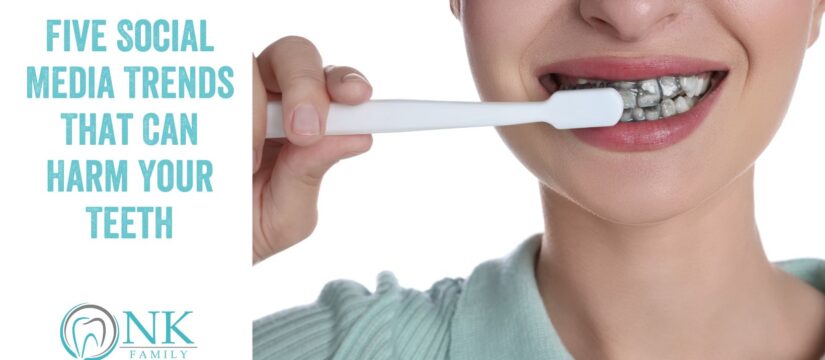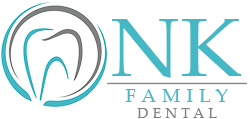
Following your favorite social media platforms — like TikTok, Instagram and YouTube — is fun, and can be informative. But if you’re looking for ways to improve your smile, the advice, life hacks and instructions for DIY solutions that don’t involve a dental professional can do far more harm than good – including losing your teeth! And if you think trying some of the hacks listed here will save you money, fixing the damage will cost even more than if you had sought appropriate treatment by a dentist or orthodontist. Not to mention that “fixing the damage” could mean you wear dentures for life!
Keeping this in mind, here are the top five trends that can permanently harm your teeth.
1. DIY Braces
There are many video tutorials about how to make your own braces using a variety of household items — including earring backs, paper clips, fishing line, dental floss, etc. DIY braces kits also are easy to find online. People with access to 3D printers have created Invisalign-style aligners. However you fashion them, they’re all dangerous — as are gap bands, which are rubber bands used to close gaps between teeth. Here’s why these are DIY dental hacks to avoid, according Burlingame Smile Studio and DeJesus Dental Group (and every other dentist and orthodontist in the world).
You risk permanent damage to your teeth — Damage can occur before you know what’s happening, including the following:
- Painful bone damage, tooth wear and tooth loss.
- Jaw and gum damage.
- Oral infection caused by bacteria from foreign objects in your mouth.
- Creation of new gaps between teeth.
Your teeth can fall out — DIY braces can cause your teeth to fall out. Gap bands or DIY braces can work their way below the gums on your teeth and end up around the roots. If this happens, your teeth can and will fall out.
Movement with orthodontics is precise — When moving the teeth, there is precision required. In fact, moving the teeth too quickly can cause them to become damaged. If the roots resorb in the mouth, then they may dissolve, which can lead to tooth loss. DIY braces often lead to serious other dental issues, such as issues with the jaw joints, clenching, shooting pain and muscle spasms.
Orthodontists are trained for treatment — Orthodontists spend 10 years learning about the teeth and training to become an orthodontist. In fact, they spend two to three years just learning orthodontics alone.
As for gap bands, they’re easily available in stores and online. However, the pressure from the tight band causes fast and harmful movement in the teeth. As just mentioned, the band also can move into the gumline and irritate the roots of the teeth, destroying the bone and soft tissue, causing tooth loss. The American Association of Orthodontics reported that nearly 13% of its member orthodontists have consulted with people who have tried DIY teeth-straightening. Rubber bands were one of the commonly used tools, which for some caused irreparable damage.
2. DIY Teeth Whitening Hacks
Everybody wants bright, white teeth! If you can get them by using a natural product you may already have in your kitchen cabinet or fridge, all the better, right? Not necessarily. Golden State Dentistry provides the following popular DIY whitening hacks, and how they can damage tooth enamel — which doesn’t regenerate. Once enamel is gone, it’s gone!
Strawberries — This hack has been touted as a natural way to bleach your smile. Unfortunately, the malic acid contained in strawberries can also eat away at enamel. That’s not to say you should avoid strawberries at all costs — we’d just advise against using them as an at-home whitening treatment.
Baking soda and lemon juice — Used as a homemade teeth whitening paste, both are another harmful DIY teeth whitening trend. While baking soda has mild abrasive properties that can help remove surface stains, excessive use or scrubbing can erode the enamel and lead to tooth sensitivity. Lemon juice, on the other hand, is highly acidic and can also contribute to enamel erosion and tooth sensitivity.
Hydrogen peroxide — This is another trendy DIY teeth whitening method. While hydrogen peroxide is a common ingredient in professional teeth whitening products, it should be used with caution and under the supervision of a dental professional. The concentration and application method of hydrogen peroxide can greatly impact its effectiveness and safety. Using high concentrations or applying it incorrectly can lead to gum irritation, tooth sensitivity and even chemical burns.
3. Charcoal Toothpaste
Activated charcoal has emerged as a major trend in the toothpaste market, based on its reputation for whitening teeth and neutralizing bacteria. Once a boutique product with limited availability, charcoal toothpaste has gone mainstream, being produced by major brands and sold on the oral care aisle of supermarkets, drugstores and big box retailers throughout the United States.
Brushing with a toothpaste containing activated charcoal won’t harm your teeth with occasional use. But if whitening your teeth is your primary goal, it isn’t likely to be particularly effective. And if you’re determined to continue until you see results like those promoted on social media and beauty blogs, long-term use can have detrimental consequences, including the following:
Charcoal toothpaste is too abrasive for regular use — Although charcoal is a mild abrasive, it’s still too abrasive for daily use. It can wear down tooth enamel, which — ironically — will make your teeth appear more yellow. When enamel is worn away, it exposes more of the dentin underneath, which is a yellowish color. Worn-away enamel will also make your teeth more sensitive. Also, as mentioned earlier, enamel loss is permanent.
Most charcoal toothpaste brands don’t contain fluoride — Fluoride helps keep tooth enamel strong and protects against cavities. As our blog post — “What to Look for In a Toothpaste” — covers, fluoride is a natural mineral that’s used in most toothpaste brands to help harden tooth enamel, thereby strengthening teeth. Some activated charcoal toothpastes (usually those of major brands) do contain fluoride. Read the packaging to be sure.
Charcoal toothpaste can stain teeth — Obviously not what you’d expect from a product hyped for whitening teeth. However, charcoal particles can get caught in the small cracks of teeth and leave teeth gray or black around the edges.
Unknown effects on dental restorations — Because charcoal toothpaste is still a new trend, the long-term effect on such dental restorations as veneers, crowns or bridges isn’t yet known.
In addition to these drawbacks, there are certain circumstances in which activated charcoal toothpaste should not be used. Avoid it if you are pregnant, nursing, using birth control or any type of oral medication. Charcoal toothpaste that’s accidentally swallowed during brushing can decrease the absorption rate of certain medications. Our blog post — “Should You Use Charcoal Toothpaste?” covers this topic in greater detail.
4. DIY Teeth Filing
Enameloplasty is a cosmetic dental procedure to remove small amounts of tooth enamel to change a tooth’s size, shape, length, or surface. It’s typically performed on front teeth for aesthetic reasons, such as fixing a chipped tooth or making teeth a more uniform length. When performed by a dentist or orthodontist, it’s a safe procedure that will achieve the desired result. But when performed DIY with a nail file, it presents significant risks to your long-term oral health. Here’s what can go wrong, according to the American Association of Orthodontists.
Enamel damage and tooth sensitivity — DIY teeth filing can easily remove too much enamel — which can’t grow back — increasing tooth sensitivity and raising the risk of tooth decay.
Misaligned teeth and bite problems — Professional orthodontic procedures are performed with precision, taking into account the harmony of your bite and jaw alignment. Improper filing can result in uneven teeth, affecting how your teeth come together (your bite) and leading to jaw pain, difficulty chewing and other orthodontic issues.
Infection and long-term dental issues — Using non-sterile tools like nail files to file teeth can introduce bacteria into your mouth, increasing the risk of infection. Moreover, incorrect filing techniques can cause cracks or fractures in the teeth, leading to serious dental problems requiring extensive treatment.
Irreversible changes — Any changes you make through filing are permanent and, if done incorrectly, can lead to a lifetime of dental issues that are often costly and complex to correct.
5. Attaching Accessories to Teeth
Dental bling is in fashion. Tooth gem kits are available online and in retail stores, making this trend all too easy to follow. However, as Golden State Dentistry cautions, the adhesive used to attach these accessories may contain harmful chemicals that can irritate the gums and cause inflammation. It can also create a breeding ground for bacteria, leading to gum infections and tooth decay. Additionally, the pressure exerted by the attached accessories can weaken the teeth and even cause them to fracture or chip.
“Moreover, the presence of foreign objects on the teeth can disrupt the natural balance of the oral cavity, making it difficult to maintain proper oral hygiene. Brushing and flossing around these accessories becomes challenging, increasing the risk of plaque buildup, bad breath and gum disease.”
One more caution: Tooth jewelry application is being offered as a service in some salons and tattoo studios. Although these services claim the adhesive they use is safe for enamel, no one other than a licensed dentist should ever touch your teeth!
The Take-Home Message
The desire for an attractive smile is understandable, and worth pursuing. But taking DIY shortcuts promoted on social media to save money is ultimately counterproductive and can cause long-term or permanent damage to your teeth that will be even more expensive to mitigate. At NK Family Dental, we understand that the main concern you may have is cost, which is why we accept all major PPO plans for dental insurance and also offer our in-house dental plan. Please see our financing page for more information.
It is our mission to provide the highest quality and most compassionate oral care to our Chicago patients, including both dental and periodontal services. Our practice is trusted for advanced oral surgery procedures and comfortable root canal treatment.
Our team of experienced, dedicated dental professionals will help address your oral health concerns, and determine the best solution for you based on your individual situation. We strive to identify treatment options that fit your needs. Our dental specialists include our general dentist, Dr. Nilofer Khan, our endodontist, Dr. Sabek, and our periodontist, Dr. Amir Danesh. Dr. Danesh is a board-certified periodontist and Diplomat of the American Board of Periodontology. He has contributed to the publication of two books, as well as published over 20 papers in prestigious dental research journals.
We serve the neighborhoods of Logan Square, Bucktown, Humboldt Park, and Wicker Park with the dedication that’s earned us the reputation as the Best Dentist in Chicago!
We understand that the main concern you may have is cost, which is why we accept all major PPO plans for dental insurance and also offer our in-house dental plan. Please see our financing page for more information.
Schedule your visit through ZocDoc, or contact us directly. We look forward to treating you soon!
